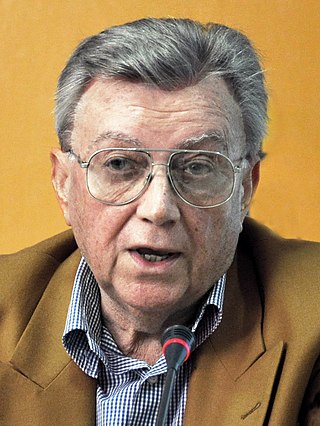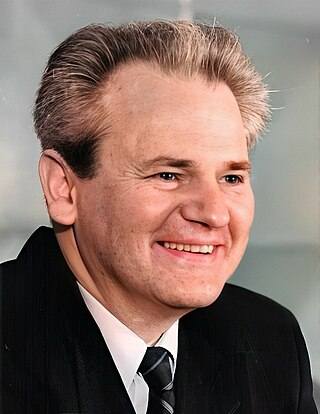Related Research Articles

The siege of Sarajevo was a prolonged blockade of Sarajevo, the capital of Bosnia and Herzegovina, during the Bosnian War. After it was initially besieged by the forces of the Yugoslav People's Army, the city was then besieged by the Army of Republika Srpska. Lasting from 5 April 1992 to 29 February 1996, it was three times longer than the Battle of Stalingrad, more than a year longer than the siege of Leningrad, and was the longest siege of a capital city in the history of modern warfare.

Alija Izetbegović was a Bosnian politician, Islamic philosopher and author, who in 1992 became the first president of the Presidency of the newly independent Republic of Bosnia and Herzegovina. He later served as the first chairman of the Presidency of Bosnia and Herzegovina.

The Republic of Serbian Krajina or Serb Republic of Krajina, known as the Serbian Krajina or simply Krajina, was a self-proclaimed Serb proto-state, a territory within the newly independent Republic of Croatia, which it defied, and which was active during the Croatian War of Independence (1991–95). It was not recognized internationally. The name Krajina ("Frontier") was adopted from the historical Military Frontier of the Habsburg monarchy (Austria-Hungary), which had a substantial Serb population and existed up to the late 19th century. The RSK government waged a war for ethnic Serb independence from Croatia and unification with the Federal Republic of Yugoslavia and Republika Srpska.

The Bosnian War was an international armed conflict that took place in Bosnia and Herzegovina between 1992 and 1995. The war is commonly seen as having started on 6 April 1992, following a number of earlier violent incidents. The war ended on 14 December 1995 when the Dayton accords were signed. The main belligerents were the forces of the Republic of Bosnia and Herzegovina, the Republic of Herzeg-Bosnia, and the Republika Srpska, the latter two entities being proto-states led and supplied by Croatia and Serbia, respectively.

After a period of political and economic crisis in the 1980s, the constituent republics of the Socialist Federal Republic of Yugoslavia split apart, but the unresolved issues caused a series of inter-ethnic Yugoslav Wars. The wars primarily affected Bosnia and Herzegovina, neighbouring parts of Croatia and, some years later, Kosovo.

The Croatian War of Independence was an armed conflict fought from 1991 to 1995 between Croat forces loyal to the Government of Croatia—which had declared independence from the Socialist Federal Republic of Yugoslavia (SFRY)—and the Serb-controlled Yugoslav People's Army (JNA) and local Serb forces, with the JNA ending its combat operations in Croatia by 1992.

The Croatian Republic of Herzeg-Bosnia was an unrecognized geopolitical entity and quasi-state in Bosnia and Herzegovina. It was proclaimed on 18 November 1991 under the name Croatian Community of Herzeg-Bosnia as a "political, cultural, economic and territorial whole" in the territory of Bosnia and Herzegovina, and abolished on 14 August 1996.

Borisav Jović was a Serbian economist, diplomat and politician who served as the President of the Presidency of Yugoslavia from 1990 to 1991.
The Yugoslav Wars were a series of armed conflicts on the territory of the former Socialist Federal Republic of Yugoslavia (SFRY) that took place between 1991 and 2001. This article is a timeline of relevant events preceding, during, and after the wars.
On 25 March 1991, the presidents of the Yugoslav federal states SR Croatia and SR Serbia, Franjo Tuđman and Slobodan Milošević, met at the Karađorđevo hunting ground in northwest Serbia. The publicized topic of their discussion was the ongoing Yugoslav crisis. Three days later all the presidents of the six Yugoslav republics met in Split. Although news of the meeting taking place was widely publicized in the Yugoslav media at the time, the meeting was overshadowed by the crisis in progress, that would lead to the breakup of Yugoslavia.

Slobodan Milošević was a Yugoslav and Serbian politician who was the President of Serbia between 1989-97 and President of the Federal Republic of Yugoslavia from 1997 until his оverthrow in 2000. Milošević played a major role in the Yugoslav Wars and became the first sitting head of state charged with war crimes.

Serbia was involved in the Yugoslav Wars, which took place between 1991 and 1999—the war in Slovenia, the war in Croatia, the war in Bosnia, and Kosovo. From 1991 to 1997, Slobodan Milošević was the President of Serbia. Serbia was part of the Federal Republic of Yugoslavia (FRY). The International Criminal Tribunal for the Former Yugoslavia (ICTY) has established that Milošević was in control of Serb forces in Bosnia and Herzegovina and Croatia during the wars which were fought there from 1991 to 1995.

The Bijeljina massacre involved the killing of civilians by Serb paramilitary groups in Bijeljina on 1–2 April 1992 in the run-up to the Bosnian War. The majority of those killed were Bosniaks. Members of other ethnicities were also killed, such as Serbs deemed disloyal by the local authorities. The killings were committed by a local paramilitary group known as Mirko's Chetniks and by the Serb Volunteer Guard, a Serbia-based paramilitary group led by Željko "Arkan" Ražnatović. The SDG were under the command of the Yugoslav People's Army (JNA), which was controlled by Serbian President Slobodan Milošević.
An independence referendum was held in Bosnia and Herzegovina between 29 February and 1 March 1992, following the first free elections of 1990 and the rise of ethnic tensions that eventually led to the breakup of Yugoslavia. Independence was strongly favored by Bosniak and Bosnian Croat voters while Bosnian Serbs boycotted the referendum or were prevented from participating by Bosnian Serb authorities.
The Leaders of the Yugoslav Wars listed below comprise the important political and military figures of the Yugoslav wars.

The Dubrovnik Republic was a Serb proto-state that existed during the Siege of Dubrovnik in the Croatian War of Independence, self-proclaimed by the Yugoslav People's Army on 15 October 1991 in occupied areas of Croatia, after being captured by members of 2nd Corps of the Yugoslav People's Army (JNA). Its provisional president was Aleksandar Aco Apolonio.
The Vance plan was a peace plan negotiated by the former United States Secretary of State Cyrus Vance in November 1991 during the Croatian War of Independence. At that time, Vance was the Special Envoy of the Secretary-General of the United Nations; he was assisted by United States diplomat Herbert Okun during the negotiations. The plan was designed to implement a ceasefire, demilitarize parts of Croatia that were under the control of Croatian Serbs and the Yugoslav People's Army (JNA), allow the return of refugees, and create favourable conditions for negotiations on a permanent political settlement of the conflict resulting from the breakup of Yugoslavia.
The RAM Plan, also known as Operation RAM, Brana Plan, or Rampart-91, was a military plan developed over the course of 1990 and finalized in Belgrade, Serbia, during a military strategy meeting in August 1991 by a group of senior Serb officers of the Yugoslav People's Army (JNA) and experts from the JNA's Psychological Operations Department. Its purpose was organizing Serbs outside Serbia, consolidating control of the Serbian Democratic Parties (SDS), and preparing arms and ammunition in an effort of establishing a country where "all Serbs with their territories would live together in the same state." A separate group of undercover operatives and military officers was charged with the implementation of the plan. These people then undertook numerous actions during the Yugoslav Wars that were later described as ethnic cleansing, extermination and genocide.
The partition of Bosnia and Herzegovina was discussed and attempted during the 20th century. The issue came to prominence during the Bosnian War, which also involved Bosnia and Herzegovina's largest neighbors, Croatia and Serbia. As of 2024, the country remains one state while internal political divisions of Bosnia and Herzegovina based on the 1995 Dayton Agreement remain in place.
References
- ↑ Iordanova, Dina (2013). "Yugoslavia: Death of a Nation". In Aitken, Ian (ed.). The Concise Routledge Encyclopedia of the Documentary Film. London: Routledge. pp. 1025–1027. ISBN 9781136512063.
- 1 2 3 "Yugoslavia: Death of a Nation". peabodyawards.com. Retrieved 20 May 2015.
- ↑ "The Death of Yugoslavia - IMDb". IMDb .
- ↑ "The Alfred I. DuPont-Columbia University Awards | Columbia Journalism School".
- ↑ ICTY
- ↑ here